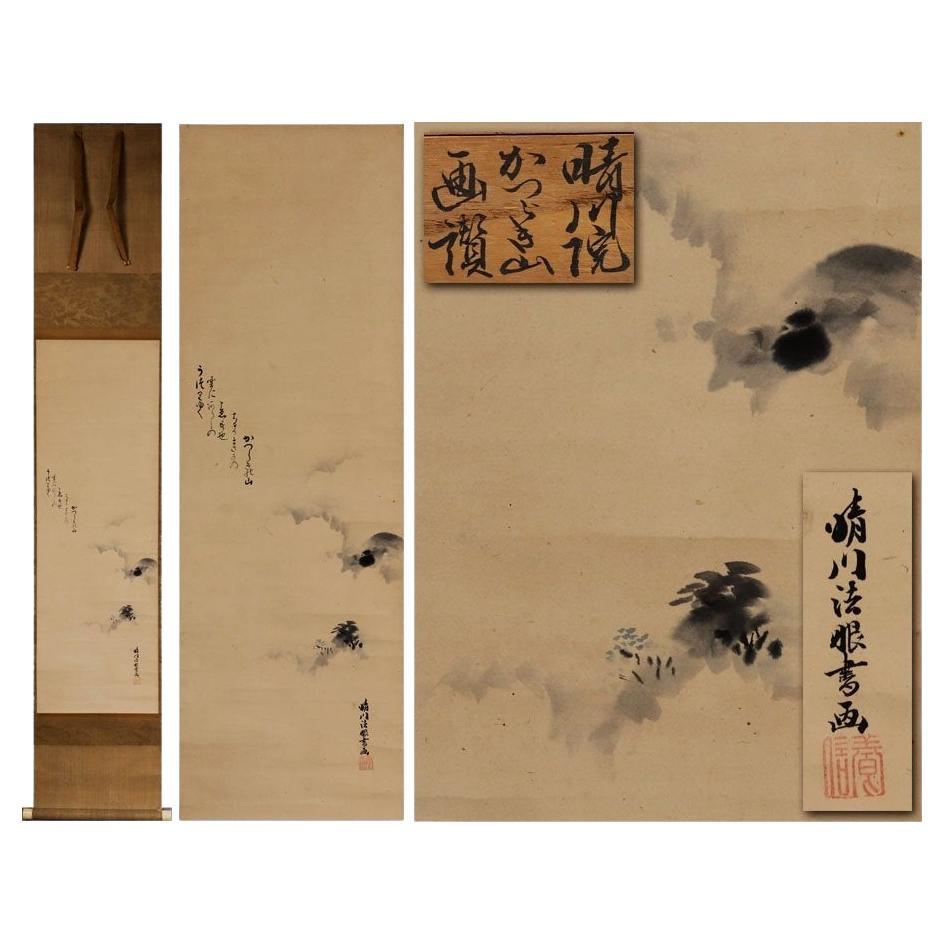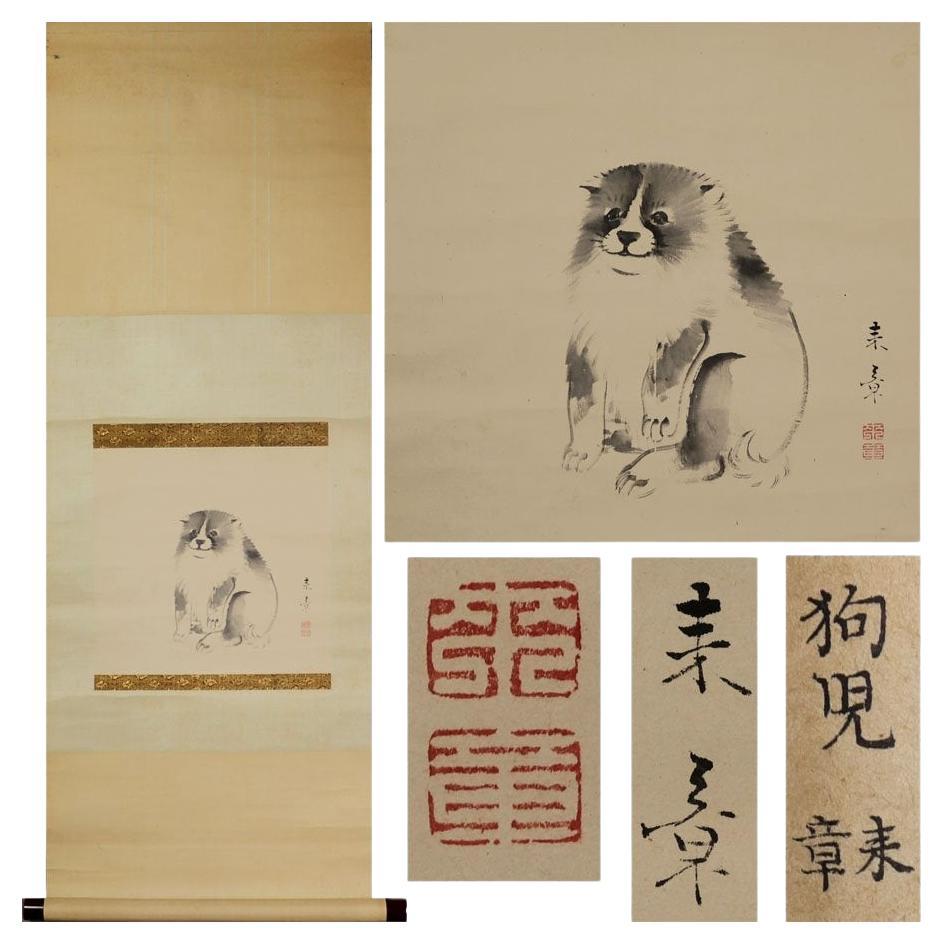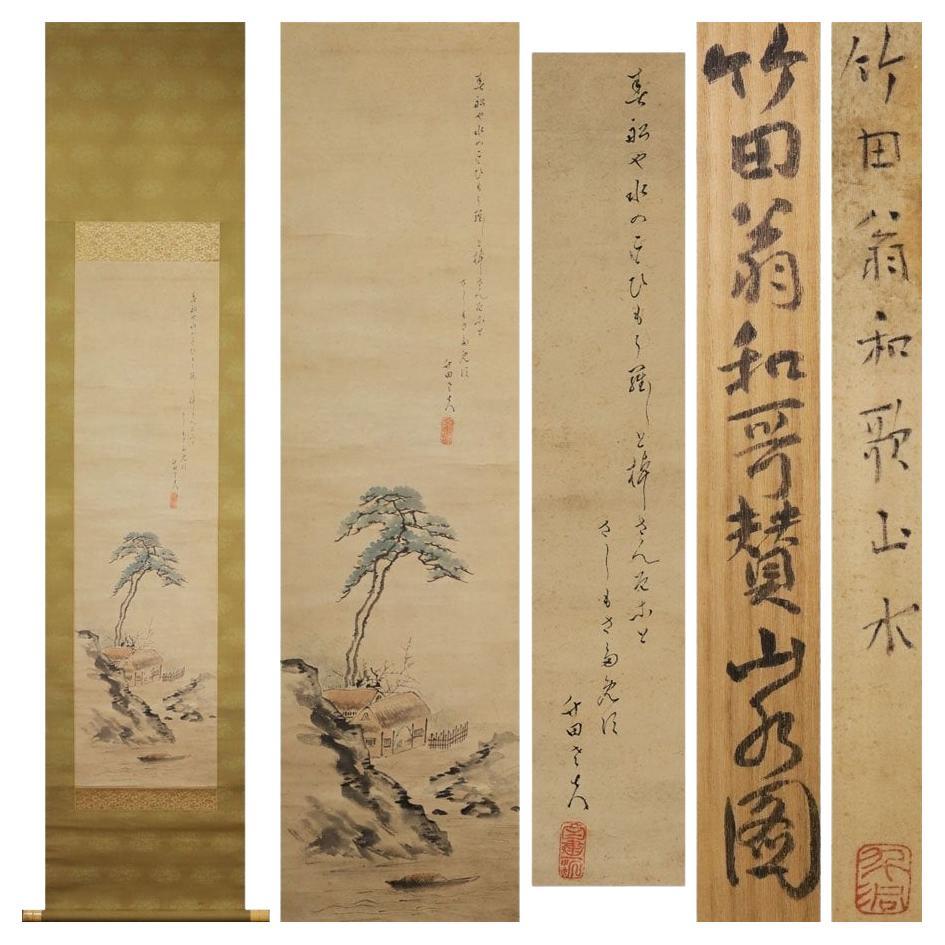Items Similar to Lovely Japanese 19th c Edo Scroll Tosa Mitsufumi Nihonga Painting Rising Sun
Want more images or videos?
Request additional images or videos from the seller
1 of 14
Lovely Japanese 19th c Edo Scroll Tosa Mitsufumi Nihonga Painting Rising Sun
About the Item
Product Description
The item below was hand-painted by Mitsufumi Tosa.It
depicts a torii gate at the rising sun, making it perfect for New Year's and auspicious occasions.
[Tosa Mitsufumi]
1812-1879 Painter from the late Edo period to the Meiji period.
Born in Kyoto. His character is Zi Bing. His name is Hansu. His name is also called ``Mitsuaya''.
Born on March 25, Bunka 9. The second son of Mitsutaka Tosa. He is the father of Mitsuaki Tosa.
He was adopted by Tosa Koroku, the head of the Tosa school, and became the guardian of the school.
He served as the head painter during the construction of the Imperial Palace. He passed away on November 9, 1898. He was 68 years old.
■Paperback/Handpainted
■Condition:
There are discolorations and scratches due to the age.
■Dimensions
Axis dimensions: approx. 176.0cm x approx. 37.0cm.
Main paper dimensions: approx. 102.0cm x approx. 29.0cm.
■Inscriptions
There are inscriptions and inscriptions, etc. as shown.
■Box
with box.
- Dimensions:Height: 69.3 in (176 cm)Width: 14.57 in (37 cm)Depth: 0.04 in (1 mm)
- Style:Edo (Of the Period)
- Materials and Techniques:
- Period:
- Date of Manufacture:1860
- Condition:Wear consistent with age and use.
- Seller Location:Amsterdam, NL
- Reference Number:
About the Seller
5.0
Gold Seller
These expertly vetted sellers are highly rated and consistently exceed customer expectations.
Established in 2015
1stDibs seller since 2019
158 sales on 1stDibs
Typical response time: 9 hours
- ShippingRetrieving quote...Ships From: Amsterdam, Netherlands
- Return PolicyA return for this item may be initiated within 14 days of delivery.
More From This SellerView All
- Lovely Japanese 19th c Edo Scroll Okumura Sekiran Nihonga Painting MountainLocated in Amsterdam, Noord Holland"Early Summer Colored Waterfall" is a work drawn by Sekiran Okumura as you can see. The brilliance of the fresh greenery and the cool, powerful presence of the waterfall are overw...Category
Antique 18th Century Edo Paintings
MaterialsSilk
- Lovely Japanese 18/19th c Edo Scroll Kano Osanobu Nihonga Painting MountainLocated in Amsterdam, Noord HollandKano Osanobu (狩野養信) Osanobu Kano (born August 18, 1796; died June 12, 1846) was the ninth painter of the Kobikicho Kano School in the Edo period. His common name was Shozaburo. His ...Category
Antique 18th Century Edo Paintings
MaterialsSilk
- Lovely Japanese Nihonga 19th c Edo Scroll by Okamoto Sukehiko , Winter HermitLocated in Amsterdam, Noord Holland[Authentic work] ◆ Akihiko Okamoto ◆ Winter forest landscape ◆ Japanese painting ◆ Hand-painted ◆ Paper ◆ Hanging scroll ◆ Okamoto (Sukehiko Okamoto) Sukehiko Okamoto [Art yearbook ...Category
Antique 19th Century Edo Paintings
MaterialsSilk
- Japanese Nihonga Painting 19th c Edo Scroll by Nakajima Raiaki River landscapeLocated in Amsterdam, Noord Holland[Raisho Nakajima] lived from 1796 to 1871, at the end of the Edo period and early Meiji period. A person from Otsu, Omi Province (Shiga Prefecture). His name is Ziqing. His names i...Category
Antique 19th Century Edo Paintings
MaterialsSilk
- Japanese Nihonga Painting 19th c Edo Scroll by Seiki Yokoyama Landscape ShijoLocated in Amsterdam, Noord Holland[Authentic work] ◆ Seiki Yokoyama ◆ Landscape ◆ Rural landscape ◆ Japanese painting ◆ Shijo school ◆ Hand-painted ◆ Paperback ◆ Hanging scroll ◆ Seiki Yokoyama [Art yearbook appra...Category
Antique 19th Century Edo Paintings
MaterialsSilk
- Japanese Nihonga Painting 18/19th c Edo Scroll Tanomura Chikuden Self PortraitLocated in Amsterdam, Noord HollandTanomura Takeda's handwritten self-portrait hymn "Painted Landscape" with himself working in a hut Takeda Tanomura and depicts fields and mountains in spring, and is accompanied by a self-written waka poem that is thought to be about the scene. [Tanomura Takeda] A painter from Takeda Village, Naoniri District, Bungo Province (present-day Takeda City). His family was born as the second son of Ken'an, who had been a samurai physician in the Oka domain for generations. He first studied medicine, but preferred learning over medicine, and studied Chinese studies under Kimizan Karahashi, a He also learned painting techniques from Buncho Tani, and after returning to Japan, he served as the president of a domain school. He resigned his post in 1812 and traveled between Keihan and Osaka, where he interacted with Raizanyo, Shinozaki Kotake, Urakami Gyokudo, Okada Yonezanjin, Unka Shonin, Aoki Mokubei...Category
Antique 18th Century Edo Paintings
MaterialsSilk
You May Also Like
- Japanese Painting, Hanging Scroll, 19th Century Bamboo in MoonlightLocated in Kyoto, JPBamboo in moonlight Gamo Rakan (1784-1866) Hanging scroll, ink on silk. Dimensions: Scroll: 201 cm x 58 cm Image: 137 cm x 45 cm In this early 19th century work by Gamo Rakan a light ink wash applied to the silk background silhouettes the moon and suggests the atmosphere of early evening. Even though it is a literati subject, Rakan’s bamboo is quite realistic with a strong decorative style. The painting finds its inspiration from Chinese Ming dynasty painters who often used a single-tone, jet black stroke to emphasize the calligraphic nature of bamboo. In a different era, decorative would have been seen as somewhat unrefined. But increasingly in the Edo period, it was the hallmark of high style. The Japanese people, in particular the rising merchant class, had gradually become apathetic toward the traditional Sesshu and Kano schools of painting. Chinese professional and amateur painters living in the port of Nagasaki during the 18th century had a profound effect on Japanese painting and the freshness of their style and its decorative appeal contributed greatly to its popularity. Gamo Rakan’s teacher, Tani Buncho...Category
Antique Early 19th Century Japanese Edo Paintings and Screens
MaterialsSilk
- 19th Century Japanese Scroll Painting by Igarashi Chikusa, Poppies & ButterfliesLocated in Kyoto, JPPoppies & Butterflies Ink, pigment and gofun on silk Igarashi Chikusa (1774-1844) Signature: Chikusa Ran Zen Upper Seal: Ran Shuzen Lower Seal: Kyoho Dimensions: Scroll: H. 68” x W. 18” (172cm x 45cm) Image: H. 38.5’’ x W. 12.5’’ (98cm x 32cm) This composition shows elegant images of poppies and the butterflies that are inevitably drawn to them. It captures a momentary glimpse into a world both visually dazzling and startlingly realistic. The painting is infused with sensitivity and attention to seasonal change and weather conditions. The thin and fragile poppies are beautifully depicted with brilliant colors and the butterflies are similarly infused with life. The painting is on silk which requires extremely precise painting skills as no element once painted can be removed. Poppies were a favorite subject of Rinpa school artists through the ages. Originally they were somewhat abstracted but by the age of Sakai Hoitsu...Category
Antique Early 19th Century Japanese Edo Paintings and Screens
MaterialsSilk
- 19th Century Japanese Scroll Painting, Birds & Flowers of the Four SeasonsLocated in Kyoto, JPBirds and flowers of the four seasons Early to mid-19th century Ink, pigment and gofun on silk Unidentified artist Signature: S...Category
Antique 1830s Japanese Edo Paintings and Screens
MaterialsSilk
- Japanese Painting, Hanging Scroll, Mid 19th Century, Koi and Water PlantsBy Iwase HirotakaLocated in Kyoto, JPIwase Hirotaka (1808-1877) Koi and Water Plants Hanging scroll, ink, color, gold wash and gold flecks on silk Inscription: Hirotaka Seal: Ille...Category
Antique 1860s Japanese Edo Paintings and Screens
MaterialsSilk
- Japanese Painting, 17th Century, Tale of Genji, Tosa SchoolLocated in Kyoto, JPIllustration to an unidentified chapter of the Tale of Genji (Genji Monogatari) Tosa School (second half of the 17th Century) Ink, pigment, gofun and...Category
Antique Late 17th Century Japanese Edo Paintings and Screens
MaterialsGold Leaf
- Set of 6 Large Kakemonos Japanese Mythology, 19th Century Japan circa 1800 EdoLocated in Beuzevillette, FRBeautiful set of 6 large kakemonos from 19th century Japanese mythology. Paper support with a canvas pasted on the paper Wonderful set that is part of Japan's history and beliefs When not hung, the Kakemonos are rolled up. circa 1800 - Japan - Edo Period A kakemono translates as "object to hang". In Japan this refers to a painting or calligraphy, most often done on silk or paper framed in a scroll that was intended to be hung on walls or in public lighting. This particular form, which allows them to be in a roll, dates back to the Tang dynasty in China (this would be related to the copying and preservation of ancient Buddhist texts). A Kami is a deity or spirit worshipped in the Shinto religion. A Yokai is a spirit, ghost, demon, or strange apparition from the creatures of Japanese folklore. Each of these kakemonos represents a unique story: - A kami, a Japanese deity, is shown painting a rainbow. Indeed, he performs the action with his right hand while his left hand holds a kind of basket with three pots of paint. This kami has a rather closed attitude. He is standing in a dark and tormented sky. Below this figure, 8 villagers are dressed in traditional Japanese clothes. Their faces are softened. They are not afraid of the elements made by the kami above their heads. - A character with an unreal look is holding a kind of jar with his two hands, which he spills on human figures above. This being is floating in the air, probably a character from mythology, perhaps Susanoo. Underneath, villagers on umbrellas. They are trying to protect themselves as best they can from what is falling on them. One of them is carrying baskets with fish on her shoulders. A character in the background is thrown forward and falls. - On this kakemono, the god Raijin, dressed in a white and blue outfit, strikes the sky with his two drum hammers to create lightning and its thunderous sound. Surrounded by Tomoe and a long red scarf, Raijin, enraged and with dishevelled hair, creates a dark and violent storm. The villagers seem frightened by this meteorological phenomenon. One of the villagers can be seen fainting in the arms of a man. This scene may seem chaotic, but Japanese legend tells us that once a field is struck by lightning, the harvest is good. - On this kakemono, we see an unreal-looking figure holding a fan, as if he were sweeping away the bad weather, or simply producing gusts of wind. He is probably the kami of wind and air, Shina tsu-hiko. The figures below him seem surprised by so much wind. An umbrella flies away on the left, the women hold their hair and scarf, the clothes are caught in the power of the wind, there is even a woman on the ground on the bottom left. - This Kakemono represents a short moment. This Raiju is a yokai (ghost spirit...Category
Antique 19th Century Japanese Edo Paintings
MaterialsPaper





